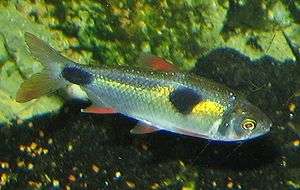Lepidophagy

Lepidophagy is a specialised feeding behaviour in fish that involves eating of scales of other fish.[1] Lepidophagy is widespread, having been independently evolved in at least five freshwater families and seven marine families.[2] Lepidophagy has been reported in a range of fish including: Chanda nama (family Ambassidae),[3] Terapon jarbua (family Terapontidae),[1] several marine catfish (family Ariidae),[4] some piranha, Exodon paradoxus and Roeboides species (family Characidae),[2][5][6] along with Perissodus eccentricus, Perissodus microlepis, Plecodus elaviae, Plecodus multidentatus, Plecodus paradoxus and Plecodus straeleni (family Cichlidae).[7][8]
Fish scales are a surprisingly nutritional food source, containing layers of keratin and enamel, as well as a dermal portion and a layer of protein-rich mucus. They are a rich source of calcium phosphate.[2] However, the energy expended to make a strike versus the amount of scales consumed per strike puts a limit on the size of the lepidophage; such fish seldom exceed 20 centimetres (7.9 inches) and most are under 12 cm (4.7 in).[2] There are a number of advantages to consuming scales: scales are common, covering the body of most fish species, can be regrown relatively quickly by "prey" fish, are abundant and seasonally reliable, and their removal requires specific behaviors or morphological structures.[2]
A diversity of morphologies and attack behaviors are used by lepidophagous predators. The behavioral origins of scale feeding may be different for different lineages.[2]
References
- 1 2 Froese, R. and D. Pauly. Editors. "Glossary: Lepidophagy". FishBase. Retrieved 2007-04-12.
- 1 2 3 4 5 6 Janovetz, Jeff (2005). "Functional morphology of feeding in the scale-eating specialist Catoprion mento" (PDF). The Journal of Experimental Biology. 208 (Pt 24): 4757–4768. doi:10.1242/jeb.01938. PMID 16326957.
- ↑ Grubh, A. R.; Winemiller, K. O. (2002). "Ontogeny of Scale Feeding in the Asian Glassfish, Chanda nama (Ambassidae)". Copeia. 2004 (4): 903–907. doi:10.1643/CE-02-095R1.
- ↑ Szelistowski, W. A. (1989). "Scale-Feeding in Juvenile Marine Catfishes (Pisces: Ariidae)". Copeia. 1989 (2): 517–519. doi:10.2307/1445459.
- ↑ Froese, R. and D. Pauly. Editors. "Exodon paradoxus,Bucktooth tetra". FishBase. Retrieved 2007-04-12.
- ↑ Petersen, C. C.; Winemiller, K. O. (1997). "Ontogenic diet shifts and scale-eating in Roeboides dayi, a Neotropical characid". Environmental Biology of Fishes. 49 (1): 111–118. doi:10.1023/A:1007353425275.
- ↑ Yanagisawa, Y. (1984). "Parental strategy of the cichlid fish Perissodus microlepis, with particular reference to intraspecific brood 'farming out'". Environmental Biology of Fishes. 12 (4): 241–249. doi:10.1007/BF00005455.
- ↑ Nshombo, M. (1991). "Occasional egg-eating by the scale-eater Plecodus straeleni (Cichlidae) of Lake Tanganyika". Environmental Biology of Fishes. 31 (2): 207–212. doi:10.1007/BF00001022.

